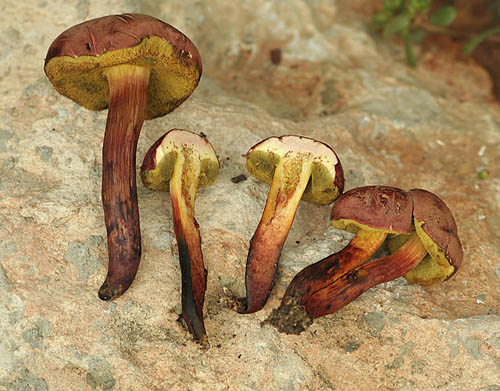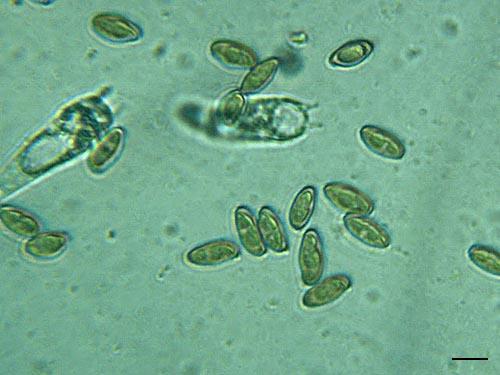Xerocomus Quél.
Recent molecular studies have shown that Xerocomus in its current circumscription is likely an artificial grouping and it is possible that it will be split at some point into smaller genera. Molecular studies also have changed our understanding about the species of xerocomoid boletes showing that morphological features are quite variable in this group. Not only microscopic study is essential for determination, but scanning electron microscope will be often needed in this “genus” as the spore ornamentation is not always seen under ordinary light microscope. Do bear in mind that macroscopic characters, such as colours, cracking cuticle, etc., tend to intergrade between the different species. Note that Boletus impolitus and Boletus depilatus that were shown to be close to Xerocomus subtomentosus and its allies, are here retained in Boletus for practical reasons. The same applies also for Phylloporus pelletieri, placed here in a genus of its own, but being also close to Xerocomus subtomentosus group.
Although large reference list will be found under most of the species, one should always consult Ladurner & Simonini (2003) having in mind that there are some new species (X. chrysonemus, X. marekii, X. silwoodensis) described after this otherwise superior book was printed. Useful keys, covering most of the European xerocomoid boletes (except some southern taxa) are provided by Knudsen & Vesterholt (2008), Hills (2008) and Kibby (2011), the later also featuring an excellent comparison chart.
Fruitbody medium to small sized, boletoid, without veil and ring. Stipe solid, often tapering towards the base. Flesh variously coloured, changing or not when exposed to air. Tubes not separable from each other, instead tearing apart. Pores usually angular.
Xerocomus dryophilus (Thiers) Singer
Description
Cap up to 10 cm, initially hemispherical, later convex to flat-convex, red, dark red, brownish red, pinkish red, sometimes discolouring to pale brown, usually dry, velvety, sometimes cracking. Stipe more or less cylindrical, often curved, bright yellow, but dark red in the base. Flesh yellow, beetroot red or reddish brown in the stipe base, mostly unchanging in the cap and slightly blueing in the stipe. Tubes yellow to olivaceous yellow, usually blueing when injured. Pores concolorous with the tubes, blueing when bruised. Smell not distinctive. Taste not distinctive. Spores 11–17 × 5–7 μm, smooth. Pileipellis a trichoderm of slender septate hyphae of long cylindrical incrusted cells.
Habitat. Warm broadleaf forests on calcareous soils, mycorrhizal with oaks (Quercus).
Distribution. So far known only from the Mediterranean area (Europe – Croatia, Greece, Italy, Spain). Possibly more widespread as it has been spotted recently also in the Near East (Israel).
Similarity. Similar to most of the reddish coloured boletes around Xerocomus rubellus and Xerocomus chrysenteron. Macroscopically distinguished on the account of the peculiar beetroot red colour of the flesh in the stipe base. Microscopically it is distinguished by its wide, smooth, non truncate spores and the cap cuticle composed of slender incrusted hyphae.
Note. It has become known recently that the European fungus is different from the American Xerocomus dryophilus (see Hills 2009). Consequently, new name will have to be assigned to the European species. There is a preliminary name given, Xerocomus guidonis, but it is not yet formally published.
Photographs

Fruitbodies of Xerocomus dryophilus. Note the typical deep red colour in the lower part of the stipe. (photo M. Floriani)

Fruitbodies of Xerocomus dryophilus. Note the peculiar red colouration of the flesh in the stipe base. (photo O. Godorova)

Spores and basidia of Xerocomus dryophilus. Scale bar = 10 μm. (photo O. Godorova)
Important literature
Hills, A.E. 2008. The genus Xerocomus. A personal view, with a key to the British species. – Field Mycology 9(3): 77–96.
Ladurner, H. & Simonini, G. 2003. Xerocomus s.l. – In: Fungi Europaei. Vol. 8. Pp. 1–527. Edizioni Candusso, Alassio.
Polemis, E., Dimou, D.M., Tzanoudakis, D. & Zervakis, G.I. 2012. Diversity of Basidiomycota (subclass Agaricomycetidae) in the island of Andros (Cyclades, Greece). – Nova Hedwigia 95: 25–58.
Simonini, G. 1998. Qualche specie rara o poco conosciuta della famiglia Boletaceae. – In: Fungi non delineati. Vol. 6. Pp. 1–56. Libreria Mykoflora, Alassio.